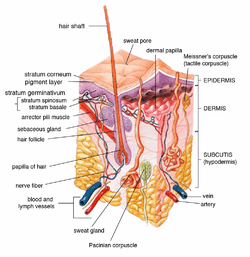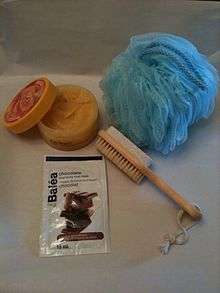Exfoliation (cosmetology)

Exfoliation involves the removal of the oldest dead skin cells on the skin's outermost surface. Exfoliation is involved in the process of all facials, during microdermabrasion or chemical peels at medical spas. Exfoliation can be achieved through mechanical or chemical means.[1]
History
Credit is given to the ancient Egyptians for the practice of exfoliation.[2] In the Middle Ages, wine was used as a chemical exfoliant, with tartaric acid as the active agent.[2] In Asia, the practice of exfoliation started hundreds of years ago.[3] The etymology of the word exfoliate comes from the Latin exfoliare (to strip off leaves).[4]
Types
Exfoliation is achieved through either mechanical or chemical means.
Mechanical

This process involves physically scrubbing the skin with an abrasive.[5] Mechanical exfoliants include microfiber cloths, adhesive exfoliation sheets, micro-bead facial scrubs, crepe paper, crushed apricot kernel or almond shells, sugar or salt crystals, pumice, and abrasive materials such as sponges, loofahs, brushes, and simply fingernails.[6][7] Facial scrubs are available in over-the-counter products for application by the user. People with dry skin should avoid exfoliants which include a significant portion of pumice, or crushed volcanic rock. Pumice is considered a good material to exfoliate the skin of the feet. Microdermabrasion is another mechanical method of exfoliation.
Chemical
Chemical exfoliants include scrubs containing salicylic acid, glycolic acid, fruit enzymes, citric acid, or malic acid which may be applied in high concentrations by a medical professional, or in lower concentrations in over-the-counter products. Chemical exfoliation may involve the use of products that contain alpha hydroxy acids (AHAs), beta hydroxy acids (BHAs), or enzymes that act to loosen the glue-like substance that holds the cells together, allowing them to ease away. This type of exfoliation is recommended for people treating acne.[8] In beauty spa treatment on continental Europe, the chemical properties of wine producing grapes are exploited in the practice of vinotherapy which is becoming increasingly popular.
With hair removal
Some methods of hair removal also exfoliate the skin.
- Waxing is a mechanical process that is performed with the intention of plucking the hair, which also functions as a mechanical exfoliant. It can be done every two to eight weeks. It is not carried out as frequently as many exfoliate. So, it does not fully substitute for a regimen, but may substitute for a normal session in a regimen.
- Nair is an example of a chemical hair removal product which also functions as a chemical exfoliant. It is done more frequently than waxing (once a week rather than once a month) since it only destroys hair partially below the skin, rather than destroying the entire root as with waxing. Using it weekly can substitute for a weekly exfoliant regime. It is a very aggressive chemical and cannot be used on the face so other exfoliants would need to be used on the face.
- Wetshaving also has exfoliating properties; first, the action of moving a shaving brush vigorously across the face washes the face and removes dead skin at the same time. After applying the lather with a brush, the use of a double-edged safety razor or straight razor removes dead skin simply by the fact that the aforementioned razors are dragged much closer across the skin and remove dead skin more effectively than the cartridge or electric razor.
Promotion
In popular media, exfoliants are advertised as treatments which promote beauty, youthful appearance, or health.[6]
Disadvantages
One disadvantage to exfoliation is the high price of some of the products and methods used to achieve it. Exfoliation will lead to some initial redness to the skin. Near the end of chemical peels, the skin will frost, with colors varying from a bright white to grey on the skin surface.[2]
Marine environmental impact of microbeads
As microbead particles used in mechanical exfoliation are too small (less than 1mm) to be caught by sewage works, this results in tonnes of microbeads being released into the environment, which damages marine ecosystems.[9] Consequently, in June 2014 the US state of Illinois became the first to ban the use of microbeads, and cosmetics manufacturers such as L'Oreal, Johnson & Johnson, and Colgate agreed to use more natural ingredients.[9]
See also
References
- ↑ "New Skin - Via Exfoliation". Reuters. Retrieved 2 December 2014.
- 1 2 3 "Medscape: Medscape Access". Emedicine.com. Retrieved 2 December 2014.
- ↑ Positano, Rock (18 September 2007). "Getting Under Your Skin". New York Post. Retrieved 4 January 2015.
- ↑ "Exfoliation - Definition and More from the Free Merriam-Webster Dictionary". Merriam-webster.com. Retrieved 2 December 2014.
- ↑ Anitra Brown. "What Is Exfoliation?". About. Retrieved 2 December 2014.
- 1 2 Alex Muniz. "Exfoliation - AskMen". AskMen. Retrieved 2 December 2014.
- ↑ Cathy Wong, ND. "How to Use a Dry Brush for Skin". About. Retrieved 2 December 2014.
- ↑ "Beauty & Skin: Facial Skin Exfoliation". Wdxcyber.com. Retrieved 2 December 2014.
- 1 2 Hitchings, Lauren (23 June 2014). "Why Illinois has banned exfoliating face washes". New Scientist. Retrieved 24 June 2014.